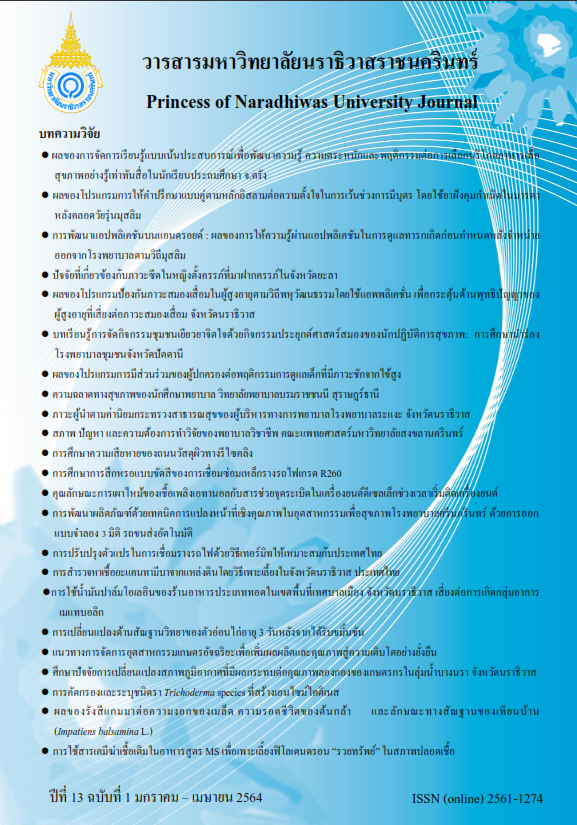Chemical Sterilization in MS Culture Medium for In vitro Culture of Philodendron sp. “Ruaysap”
Keywords:
Chemical sterilization, Haiter®, Betadine®, Philodendron, Tissue cultureAbstract
This study aimed to investigate the appropriate chemicals and concentrations for disinfection of medium used to culture Philodendron “Ruaysap” shoot tip. The shoot tips were cultured on MS medium sterilized by adding Haiter® and Betadine® at 2, 4 and 6 mL/L for 60 days. The results showed both chemicals with all concentrations were able to inhibit the growth of microorganisms. Besides, it was found that the medium sterilized by adding 2 mL/L Haiter® increased foliar growth with the maximum number, length and width of leaves (6.3 leaves, 1.39 cm, 0.82 cm, respectively). Medium sterilized by adding 2, 4 and 6 mL/L Betadine® resulted in no difference in root number and length but the addition of Betadine® at all concentrations gave the number of roots greater than those sterilized by both autoclaving and adding Haiter®. After acclimatization for 30 days in greenhouse, all complete plantlets survived and grew well. Therefore, Haiter® and Betadine® are able to replace autoclaving which is a costly method.
References
Ballarin-Denti, A., & Antoniotti, D. (1991). An experimental approach to pH measurement in the intercellular free space of higher plant tissues. Experientia, 47(5), 478 - 482.
Brondani, G., Oliveira, L., Bergonci, T., Brondani, A., França, F., Silva, A., & Gonçalves, A. (2013).Chemical sterilization of culture médium:a low cost alternative to in vitro establishment of plants. Sci. For., 14(98), 257 - 267.
Chansean, M., & Syoichi, I. (2007). Conservation of wild Orchids in Cambodia by Simple Aseptic Culture Method. Proc. NIOC, 13 - 19.
Deein, W., Thepsithar, C., Thongpukdee, A., & Tippornwong, S. (2013). Growth of Chrysanthemum Explants on MS Medium Sterilized by Disinfectants and Essential Oils. International Journal of Bioscience, Biochemistry and Bioinformatics, 3(6), 609 - 613.
Habiba, U., Reza, S., Saha, M.L., Khan, M.R., & Hadiuzzaman, S. (2002). Endogenous bacterial contamination during in vitro culture of table banana: Identification and prevention. Plant Tissue Cult, 12(2), 117 - 124.
Lepelletier, D., Maillard, J. Y., Pozzetto, B., & Simon, A. (2020). Povidone Iodine: Properties, Mechanisms of Action, and Role in Infection Control and Staphylococcus aureus Decolonization. Antimicrob Agents Chemother, 64(9), e00682-20.
Loss-Oliveira, L., Sakuragui, C., Soares, M., & Schrago, C.G. (2016). Evolution of Philodendron (Araceae) species in Neotropical biomes. PeerJ(e1744), 18.
Matsumoto, K., Coelho, M.C., Momte, D.C., & Teixera, J. B. (2009). Sterlization of non-autoclavable vessels and culture media by sodium hypochlorite for in vitro culture. Acta Horti, 839, 329 - 336.
McKeen, L. (2012). Introduction to Food Irradiation and Medical Sterilization. In The Effect of Sterilization on Plastics and Elastomers (Third Edition) (pp. 57 - 84). William Andrew.
Owen, H., Wengerd, D., & Miller, A. (1991). Culture medium pH is influenced by basal medium, carbohydrate source, gelling agent, activated charcoal, and medium storage method. Plant Cell Rep, 10(11), 583 - 586.
Pais, A., Silva, A., Souza, J., Teixeira, S., Ribeiro, J., Peixoto, A., & Paz, C. (2016). Sodium hypochlorite sterilization of culture medium in micropropagation of Gerbera hybrida cv. Essandre. African Journal of Biotechnology, 15(36), 1995 - 1998.
Ramage, C., & Williams, R. (2002). Mineral nutrition and plant morphogenesis. In Vitro Cell Dev Biol Plant, 38(2), 116 - 124.
Russell, A. D. (2003). Similarities and differences in the responses of microorganisms to biocides. Journal of Antimicrobial Chemotherapy, 52, 750 - 763.
Sharma, M., Chaudhary, R., Kureel, R., & Sengar, R. (2018). Effects of culture media pH on In Vitro shoot multiplication in sugarcane. International Journal of Chemical Studies, 6(2), 1308-1310.
Shi, X., Yang, L., Yan, G., & Du, G. (2017). Medium pH between 5.5 and 7.5 has Minimal Effects on Tissue Culture of Apple. HORTSCIENCE, 52(3), 475 - 478.
Technical Service Group of Occidental Chemical Corporation. (2014). Sodium hypochlorite handbook. Dallas: OxyChem.
Teixeira, S. L. (2006). The development of a new protocol that uses sodium hypochlorite to replace the autoclaving procedure for establishing axenic in vitro banana (Musa sp.) culture. Agricell Report, 47(3), 17 - 18.
Weber, B., Witherell, R., & Charkowski, A. (2015). Low-cost potato tissue culture with microwave and bleach media preparation and sterilization. Am. J. Potato Re, 92, 128 - 137.
Yanagawa, T., Nagai, M., Ogino, T., & Maeguch, M. (2006). Application of disinfection to orchid seeds, plantlet and media as a means to prevent in vitro contamination. Lindleyana, 10, 33 - 36.




